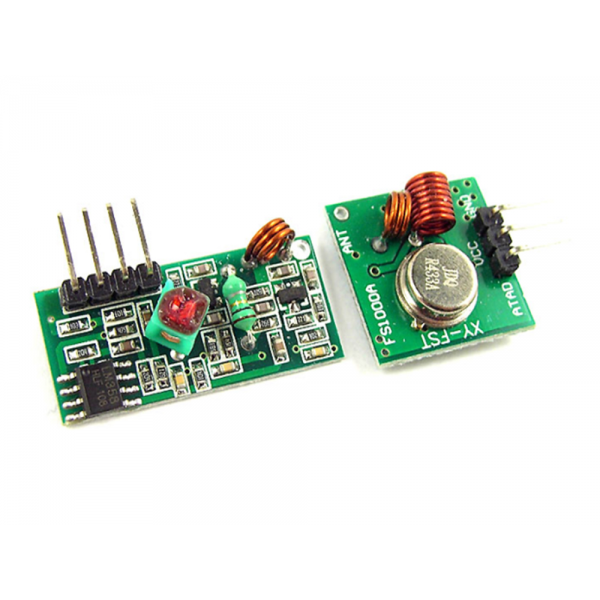Модуль 315M (super regenerative module)
5,00 руб.
Features:
The excellent performance of the receiver module, using a digital process technology, with a strong anti-interference, stable performance, high reliability, non-directional, long life, undisturbed Japan imported chips, high stability, low power consumptionsimilar remote control does not have any interference garbled phenomenon, the transmitted signal of the wireless receiver, remote control distance, can pass through walls, no direction. Supporting the use of any of the same frequency remote control can be and market fixed code, learning code.
Super-regenerative receiver module LC oscillator circuit includes amplifier shaping output data signals to TTL level directly to the decoder, the use of extremely easy, and inexpensive, it is widely used. The small size, high sensitivity; frequency point debugging easy, short lead times; consistency of product quality, cost-effective, wireless remote control market, the largest amount the most widely used as a high-frequency receiver module. The receiver module has a wide receiver bandwidth, typically ± 10MHz, factory tune in 433.92MHZ DC5V power supply receiver module.
Static receiver module operating current of 4mA, the receiver module factory output noise output, if there are special requirements can be changed to the noise-free output, but will reduce receiver sensitivity.
Receiver module specification:
Transmitter Module Specification:
We tried them using the guide from Sparkfun, it’s compatible. The only difference is in package, of some excess GND pins. More over, we will make more RF modules ourselves with different frequency and capacity.
If the distance required for far, can be connected to the 1/4 wavelength of the antenna, generally use 50 ohm single conductor, the length of the antenna 315M of about 23cm, 433M of about 17cm;
The position of the antenna has also affected the reception of the module, install the antenna as straight as possible away from the shield, high pressure, and interference sources;
The excellent performance of the receiver module, using a digital process technology, with a strong anti-interference, stable performance, high reliability, non-directional, long life, undisturbed Japan imported chips, high stability, low power consumptionsimilar remote control does not have any interference garbled phenomenon, the transmitted signal of the wireless receiver, remote control distance, can pass through walls, no direction. Supporting the use of any of the same frequency remote control can be and market fixed code, learning code.
Super-regenerative receiver module LC oscillator circuit includes amplifier shaping output data signals to TTL level directly to the decoder, the use of extremely easy, and inexpensive, it is widely used. The small size, high sensitivity; frequency point debugging easy, short lead times; consistency of product quality, cost-effective, wireless remote control market, the largest amount the most widely used as a high-frequency receiver module. The receiver module has a wide receiver bandwidth, typically ± 10MHz, factory tune in 433.92MHZ DC5V power supply receiver module.
Static receiver module operating current of 4mA, the receiver module factory output noise output, if there are special requirements can be changed to the noise-free output, but will reduce receiver sensitivity.
Receiver module specification:
- Operation voltage: DC5V
- Static Current: 4MA
- Receiver frequency: 433.92MHZ; 315 Mhz
- Sensitivity??105DB
- Dimension?30*14*7mm
- External Antenna?32CM signal wire?spiral
Transmitter Module Specification:
- Operating voltage :3-12V
- Operating frequency: 433.92MHz; 315Mhz
- Standby current: 0mA
- Operating current :20-28mA
- Transmission distance:> 500m (open to receiving plate sensitivity at-103dBm distance of more than)
- Output Power: 16dBm (40mW)
- Transfer rate: <10Kbps
- Modulation mode: OOK (Amplitude Modulation)
- Operating Temperature: -10 ? ~ +70 ?
- Size: 19 × 19 × 8mm
We tried them using the guide from Sparkfun, it’s compatible. The only difference is in package, of some excess GND pins. More over, we will make more RF modules ourselves with different frequency and capacity.
If the distance required for far, can be connected to the 1/4 wavelength of the antenna, generally use 50 ohm single conductor, the length of the antenna 315M of about 23cm, 433M of about 17cm;
The position of the antenna has also affected the reception of the module, install the antenna as straight as possible away from the shield, high pressure, and interference sources;
| Гарантийный срок (месяцев) | - |








